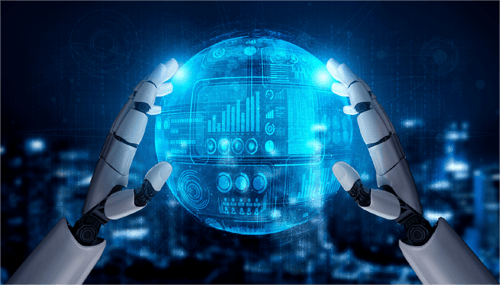15 Impacts of Generative AI on Software Development—According to AI
A lot has already been said about how the explosion in generative AI technology will impact our daily lives in the very near future. In many industries, it’s already happening—including one that’s near and dear to me personally, software development and engineering.
There’s no arguing the fact that AI-powered code generation and related tools are revolutionizing how software gets created, tested, and deployed. And the effects we’re already seeing are just the tip of the iceberg.
I firmly believe that the evolution of generative AI development tools represents the single biggest sea change in software engineering in… well, maybe of all time.
Reading up on the topic, I started to wonder what the AIs make of their own impact. What would happen if I asked AI to turn the lens on itself?
The next three sections of this article were primarily written by AI (a combination of ChatGPT, Jasper, Simplified, and WriteCream). I just organized them and added a few comments in italics.
Positive Impacts
I think all would agree the following impacts are net positive for the industry.
Increased productivity
Generative AI is revolutionizing the software development industry by reducing time and increasing productivity. With its ability to automate repetitive tasks, such as creating UIs, tests, and documentation, developers can focus on more complex tasks while generative AI handles the rest. As per KPMG, this technology can drastically cut down the time required to develop complex codebases by up to 90%. This not only leads to faster time-to-market for products but also enables companies to optimize their resources while delivering top-notch output.
Improved quality
Generative AI has the potential to enhance the quality of software development by minimizing errors and maximizing precision. One illustration of this is its ability to generate high-level architecture diagrams using a set of inputs or specifications, which helps guarantee that all system components are properly integrated.
Furthermore, generative AI promises to boost the effectiveness of current static-analysis tools in detecting bugs. Generative AI also offers a solution to the inherent risks associated with manual coding errors and unexpected bugs in software development. With automated processes, generative AI minimizes these risks, ultimately reducing costly downtime and data loss.
There’s no arguing that speed and quality are paramount in modern software development. That’s been the case for years now. We used to say, ‘you can have it quickly, or you can have it right, but you can’t have both.’ Agile, DevOps, and a host of other improvements in processes and tools have changed that. And the standards are only rising.
Automating non-creative tasks like documentation and regression testing are well within AI’s wheelhouse and can only make a developer’s life easier and a business more competitive.
More personalized experiences
Through the application of generative AI, software developers can create a more personalized user experience based on individual user data. This can lead to greater engagement and improved satisfaction with the software applications. By leveraging the capabilities of generative AI, programmers can optimize their products to better serve the unique needs and preferences of their users.
New business models
Due to the increasing prevalence of generative AI in software development, businesses could potentially explore new models centered around automated code generation and other AI-powered services.
I think this is really exciting: any time a new disruptive technology enters the market, it opens up brand new possibilities for products and services—entire businesses—that never existed before. Visionary entrepreneurs will take this ball and run with it. In fact, they already have.
Good and Bad Impacts
Depending on how you look at it, and especially on your appetite for risk/reward in business, these effects may be positive or negative.
Greater expectations from businesses
The use of generative AI in coding presents both benefits and challenges. While it allows for faster coding, it also means managing larger amounts of code while meeting higher demands for speed and accuracy from businesses. This can add a significant amount of pressure on developers who may not have the requisite skills or resources to keep up with these expectations. It is important for organizations to provide their developers with adequate support to achieve optimal results when implementing generative AI into their workflows.
With the increasing utilization of generative AI in businesses, software teams must be equipped to handle higher quality products that meet industry standards with fast turnaround times. Developers need to anticipate and prepare for these demanding expectations if they want their projects to succeed in today’s fiercely competitive market.
Increased competition
Generative AI has the unique potential to reduce barriers to entry for developers who are working on complex codebases. This technology also opens up new possibilities for companies, enabling them to achieve goals that were previously impossible or financially unfeasible – such as hiring less experienced developers at lower costs. These developments could potentially lead to a more competitive job market for software engineers in the near future.
Personally, I see these as positives for the industry as a whole, and especially for the customer. But, there will be growing pains for businesses working through the transition period. Change is always uncomfortable. Change on this level may be painful.
Negative Impacts
The rest of these impacts are definite risks developers and organizations need to take seriously. Only if we can successfully mitigate these will we be able to harness the full power of AI in software development.
Job displacement
The emergence of generative AI has the potential to revolutionize the development industry, as it could potentially replace the need for human developers. This shift in automation raises concerns about job displacement and career uncertainty for professionals in this field. It is becoming increasingly important for developers to stay on top of emerging technologies and adapt their skill sets accordingly in preparation for potential change in the industry.
This is the big boogeyman people have been scared of for decades when discussing AI and robotics. In many ways, it’s been proven to be groundless. But now, seeing what generative AI is capable of, and how quickly its capabilities are evolving, I agree there’s reason for concern.
Loss of creativity
With the increasing prevalence of artificial intelligence in day-to-day tasks, it’s becoming apparent that developers may become too reliant on automated solutions. This could create a potential loss of creativity and a decrease in innovation in software development. As AI takes over mundane tasks, we must ensure that we continue to challenge ourselves and push boundaries in order to maintain innovation and creativity within the field.
Lack of transparency
The opaqueness of generative AI decision-making can present a challenge in ensuring transparency and accountability within the software development process. As AI continues to advance and become more complex, it is important that we prioritize understanding and implementing measures for maintaining visibility into these systems. Only through diligent efforts towards transparency and accountability can we ensure ethical use of AI technology.
Security risks
The use of generative AI poses some potential security concerns, as it heavily relies on machine learning algorithms that may be vulnerable to malicious attacks or data manipulation if not properly secured or monitored.
Due to these risks, it is essential for organizations to take necessary steps to ensure the safety and security of their systems before incorporating any form of generative AI technology within their software development processes. By doing so, they can avoid any potential harm and maintain a secure and trustworthy system for their users.
Cost and complexity concerns
Although generative AI has the potential to streamline software development and bring about financial savings, there are consequential expenses that come with its implementation and upkeep. This is because it requires specialized hardware and software resources, as well as highly skilled personnel with expert knowledge on how these complex systems operate.
As the complexity of generative AI systems grows, managing and maintaining them becomes increasingly difficult due to their sheer size. This poses a significant challenge for those responsible for maintaining these systems, including engineers and data scientists alike. As algorithms continue to evolve and expand in scope, it’s critical that we find ways to optimize their operation while ensuring they remain stable and secure.
Limited customization
Generative AI may not be the optimal solution for software applications that require high customization or cater to specific niches. This limitation could restrict its utility in certain domains and industries.
Ethical concerns
As is the case with any technology, there are ethical implications that come with utilizing generative AI in software development. Issues such as privacy, data collection, and algorithmic bias need to be taken into consideration. There is a growing fear that this technology may even facilitate unethical practices such as hacking and terrorism. It’s important to approach these concerns with critical thinking and an awareness of their potential impact on individuals and society as a whole. Ultimately, we must strive for an ethically responsible use of generative AI in order to ensure its benefits are maximized while any negative consequences are minimized.
Intellectual property issues
It’s important for companies to be aware of the potential legal issues that could arise from using Generative AI technology. Specifically, there is a risk that content generated by this technology may infringe upon existing intellectual property rights. This could lead to costly legal battles and damage to a company’s reputation. It’s crucial for businesses considering the use of Generative AI to fully understand the risks involved and take measures to avoid any potential legal issues.
Regulatory challenges
Despite the increasing prevalence of generative AI technology, there is a lack of regulatory guidance from governments worldwide. This leaves companies in a state of uncertainty regarding which specific rules they need to adhere to when utilizing this technology in their operations or delivering products/services to customers and other stakeholders. In the absence of proper regulation, companies must exercise caution and seek legal advice to ensure compliance with all pertinent laws and policies.
From where I stand, all of these negative impacts must be taken seriously, but shouldn’t necessarily slam the brakes on an organization’s exploration of generative AI. It’s just too powerful a tool to ignore.
The best option companies can pursue is to identify and work with experts who can help guide them through this rocky transition period. With the right guidance and hands-on support, every software development organization will be able to capitalize on the powerful benefits AI brings to the table while minimizing the inherent risks that come along with it.
And, in the end, isn’t that what business has always been about?


